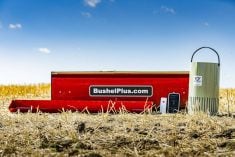An old cardboard box provides the material to make a paper gasket when a replacement isn’t available
One of the frustrations with breakdowns is they seem to occur at the worst possible time, and getting replacement parts quickly is sometimes a problem. That was the situation with this repair. But being creative can sometimes get things going again — at least temporarily — as in this case.
This small, walk-behind snowblower wouldn’t start on a holiday weekend when all the parts stores were closed. After troubleshooting the problem, the carburetor was removed and cleaned. But, the manifold gasket was badly deteriorated, and it couldn’t be reused when reinstalling the carb.
Read Also

Claas brings 1000 Series SP forage harvesters to Canada
In mid-August, Claas unveiled its new line of Jaguar forage harvesters at an event in Visalia, California, deep in the heart of that state’s dairy region.
So with snow waiting to be cleared, an old cardboard box was pulled from the recycling bin to use as material for a replacement gasket. This farm shop improvisation could be used in a variety of applications as a replacement for paper-type gaskets when an OEM replacement isn’t readily available. As an added bonus, it makes for a no-cost repair.
After removing the carb, it was clear the gasket on the intake manifold was unusable. With no replacement on hand, the old gasket was carefully removed and used as a template to create a new one.
The original gasket was a thin, paper type, but there was no replacement available. Instead, a replacement for it was cut from thin cardboard salvaged from an old 12-pack, soft drink box. A cereal box or something similar would have also worked.
The original gasket was used as a template, and the outline was traced onto the cardboard in just the same way as when cutting a gasket from any type of material. Using a pair of scissors and a sharp blade, the shape was cut out. A drill bit was used to make the mounting-bolt openings.
Be sure to use a sharp blade to create clean edges when cutting. If you have any lumps of material from the cut, trim them off to ensure the new cardboard gasket has an even thickness.
Don’t forget to clean both mounting surfaces to ensure a good seal. Any remaining material sticking to the surfaces from the old gasket was carefully trimmed off with an adjustable knife. Carb cleaner was sprayed on to dislodge any contamination and wiped off with a rag. Notice the dirt on the shop rag. It came from the two mounting surfaces.”
Be careful when cutting out the replacement — this cardboard gasket fit exactly. Once the repaired carb was reinstalled, the snowblower ran perfectly.
When using cardboard for a job like this, make sure it’s not the corrugated type. That won’t work. This piece had a thin, solid thickness.
Do you have a shop tip to share with Grainews readers? If so, email it to Scott Garvey. †















